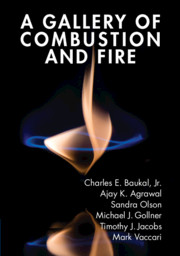Book contents
1 - Fundamental Flames
Published online by Cambridge University Press: 17 June 2020
Summary
Combustion is ubiquitous around us and in the technology that we depend on in our daily lives. To someone uninitiated in the field, observing the combustion process can produce emotions ranging from apathy, fear, boredom, conservatism, or caution to outright joy, including love and affection. Observing combustion is also a great source of fascination to many, in particular to scientists and engineers, who seek to understand the intricate relationships among the chemical, thermal, fluid dynamic, and other complex phenomena involved in the combustion process. The wide variety of fuel and oxidizers, operating conditions such as initial temperature, pressure, and concentrations, and combustor geometry configurations create virtually limitless combinations of combustion, observed visually as flame(s). For example, flames of gaseous, liquid, and solid fuels share many similarities, but they also exhibit their own unique features. Flames do not depict all of their features naturally, and thus researchers employ various diagnostics techniques, often laser-based, to measure one or more characteristics, which can also unravel the mysteries of soot, nitric oxide, and carbon oxide formation, and/or help address various safety-related issues such as flame flashback, flame blow-off, flame noise, etc. The ultimate goal of such explorations is to develop clean combustion systems that are fuel agnostic, highly efficient, and, most importantly, environmentally friendly, i.e., they produce low or very low levels of harmful emissions, including greenhouse gas emissions. This chapter presents simple canonical flames, free from the complexities of most practical combustion systems, to offer insight into the key phenomena. This chapter is divided into eight sections, each covering a different aspect of laboratory-scale flames.
- Type
- Chapter
- Information
- A Gallery of Combustion and Fire , pp. 4 - 38Publisher: Cambridge University PressPrint publication year: 2020



